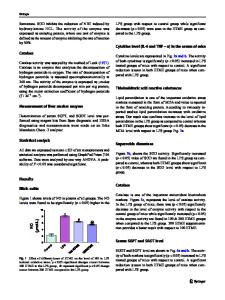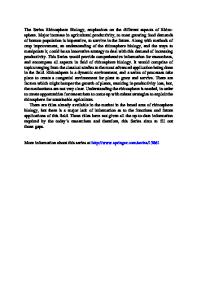Radiomodulators as Agents of Biological Protection against Oxidative Stress under the Influence of Ionizing Radiation
- PDF / 818,822 Bytes
- 15 Pages / 612 x 792 pts (letter) Page_size
- 49 Downloads / 298 Views
omodulators as Agents of Biological Protection against Oxidative Stress under the Influence of Ionizing Radiation M. V. Vasina, * and I. B. Ushakovb, c a
Russian Medical Academy of Continuous Professional Education, Ministry of Health of the Russian Federation, Moscow, Russia b Burnazyan Federal Medical Biophysical Center, Federal Medical-Biological Agency of the Russian Federation, Moscow, Russia cNikiforov All-Russia Center of Emergency and Radiation Medicine, Ministry of Emergency Situation of Russia, St. Petersburg, Russia *e-mail: [email protected] Received October 7, 2019; revised October 7, 2019; accepted October 7, 2019
Abstract—The potential mechanisms of radioprotective effect of radiomodulators as agents of “biological” protection against oxidative stress in conditions of acute and chronic irradiation at high- and low-dose-rate ionizing radiation are considered. Radiomodulators, as natural antioxidants, prevent lipid peroxidation of cell membranes and reduce radiation toxemia. The radioprotective and radiomitigative properties of natural antioxidants are limited in terms of a dose reduction factor of 1.15–1.2. The dose–effect interrelation of antioxidants has a dome-shaped character; they can be prooxidants under certain conditions. With this mechanism they are also able to reduce acute toxicity of medicines and poisons. Long, low-intensive radiation at more than 100 mSv/year causes the development of oxidative stress with activation of the mechanisms of antioxidant defense upon its further exhaustion with a decrease in the ascorbic acid content in tissues and endogenous reduced thiols. In this case, the use of natural antioxidants allows a reduction in manifestations of oxidative stress via substrate therapy, thereby compensating for vitamin deficiency under the conditions of their intense consumption. At the same time, the delivery of exogenous purine nucleoside favors the synthesis of DNA and RNA in the course of their postradiation repair. In the condition of oxidative stress, the basis of adaptation shifts in the antioxidant system eventually consists of activation of the nuclear factor Nrf2 and NAD-dependent histone deacetylases sirtuins. Via hormesis, plant polyphenols, coumarins, purine nucleosides, and melatonin can modulate the Nrf2 nuclear factor and sirtuin activity and reduce the remote consequences of chronic radiation exposure, such as a reduction of the human lifespan, by a delay of the development of atherosclerosis, cardiovascular, and neurodegenerative diseases, metabolic syndrome, diabetes mellitus, and the risk of carcinogenesis. Keywords: radiomodulators, radiation oxidative stress, radiation toxemia, natural antioxidants, ascorbic acid, plant polyphenols, xenohormesis DOI: 10.1134/S2079086420040106
INTRODUCTION In addition to radioprotectors and radiomitigators, a group of radiomodulators (Vasin, 2013) can presently be distinguished by the mechanism of the realization of the radioprotective effect of drugs. Radioprotectors (chemical protection) are antiradiation drugs that
Data Loading...









